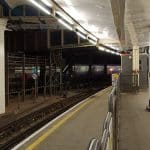Last Updated on 20/03/2023 by Alex Hamlyn
Table of Contents
Where are the plague pits in London?
The origin of the London plague pits
The Great Plague, also known as the Black Death, was a pandemic of bubonic plague that swept through the City of London between 1664 and 1666, killing an estimated 100,000 people. The only good news about this plague was that it was the last major plague epidemic in London.
With so many people dying, the existing cemeteries became overwhelmed and new burial grounds had to be established quickly and sadly, without ceremony. The London Plague Pits were mass graves used to bury the dead during the Great Plague of London in the 17th century.
For many years these pits were left undisturbed. Understandably, there was no great will or reason to dig up the pits and exhume bodies who had died of plague. But times change, and the city of London grew rich and wide and tall, and eventually, the locations of the plague pits were lost, forgotten, or built over.
Today, the exact locations of the Plague Pits are not known, but it is believed that many of them were located in the outskirts of the city, and some may still be in use as public parks or built over.
Where are the London Underground plague pits
While the exact locations of all the London Plague Pits are not known, there are some locations that are believed to have been used as mass graves during the Great Plague. Some of these include:
Clerkenwell
This neighbourhood in London is believed to have been one of the hardest hit by the Great Plague, and it is thought that several mass graves were located here.
Newchurch St. Pancras
Records indicate that a large plague pit was dug in this area to bury the dead during the Great Plague.
St Giles-in-the-Fields
This churchyard is believed to have been used as a mass grave during the Great Plague.
The Bedlam Burial Ground
The Bedlam Burial Ground, also known as the Bethlehem Hospital Cemetery, was used to bury the insane and the poor, many of whom were victims of the Great Plague.
St Dunstan’s
Today, dog walkers around the church probably pass over the skeletons of plague victims. (I hope your dog doesn’t dig too deep!)
Knightsbridge Green
It might be a glamourous postcode in the 21st century, but in the 17th century, this was where you buried your plague victims.
Vincent Square
Where today Westminster schoolchildren play above the ste of the Tothill Fields plague pit.
Vinegar Alley
An alley in Walthamstow, East London, so named for the vinegar poured over and around the pits in order to halt the disease.
For a more comprehensive record of the London plague pits, visit the database and map at Historic UK.
The exact locations of many of the London Plague Pits are not known, and much of what is known about them is based on speculation and historical records that are often incomplete or inconsistent. Nevertheless, there is still a wealth of information available about the Great Plague and the London Plague Pits, and researching this topic can be a fascinating (though morbid) journey into history.
Did plague pits affect the London Underground?
There is some evidence to suggest that the construction of the London Underground in the 19th and early 20th centuries was affected by the presence of plague pits in the city. During the construction of the London Underground, workers sometimes encountered mass graves while digging tunnels and laying tracks, and it is believed that some of these graves were remnants of the London Plague Pits.
In some cases, the workers had to halt construction and reroute the tunnels to avoid disturbing the mass graves. In other cases, the graves were disturbed during construction and the remains were moved to make way for the new infrastructure.
While the presence of plague pits may have affected the construction of the London Underground, the disease itself was not a concern during the construction. The Great Plague of London occurred in the 17th century, and by the time the London Underground was being built, the risk of infection from the disease was considered to be low. Nevertheless, the presence of mass graves and the possibility of disturbing human remains was a concern for the workers and the public, and it was often addressed with care and sensitivity.
- Green Park Station: Bones excavated during the construction of this station on the Victoria Line in the 1960s suggest this area was used as a plague pit.
- Bakerloo Line: The depot at Elephant & Castle allegedly conceals a plague pit behind the wall at the end of a runaway lane.
- Aldgate Station: According to Daniel Defoe’s book about the plague, the pit here was forty feet long, sixteen feet wide and twenty feet deep. Apparently, around 1,000 bodies were uncovered in the 1860s.
- Clerkenwell: During the construction of the Metropolitan Line in the 1860s, workers encountered several mass graves in the Clerkenwell neighborhood of London. It is believed that these graves were remnants of the London Plague Pits and were used to bury victims of the Great Plague of London in the 17th century.
- Farringdon: During the construction of the Metropolitan and Circle Lines in the late 19th century, workers encountered several mass graves near the Farringdon Station. The remains were believed to be those of victims of the Great Plague, and the graves were carefully exhumed and reburied in a nearby cemetery.
- Liverpool Street: During the construction of the Central Line in the early 20th century, workers encountered a large mass grave near the Liverpool Street Station. The remains were believed to be those of victims of the Great Plague, and the grave was carefully exhumed and reburied in a nearby cemetery.
These instances are just a few examples, and there may have been others where the construction of the London Underground was affected by the presence of plague pits. It’s hard to pin down exact details of these findings (if they are true) without detailed research.
Plague pits, ghost stories, and the London Underground
There are several ghost stories and legends associated with the London Plague Pits and the Great Plague of London. These stories often involve the spirits of the dead who were buried in the mass graves during the Great Plague of London, and they are said to haunt the underground tunnels and stations which have long disturbed their peace.
One of the most famous ghost stories associated with the London Plague Pits is the tale of the “Plague Doctor,” a hooded figure said to haunt the streets of London, searching for new victims to claim. This figure is said to be a representation of Death itself, and its appearance was thought to foretell the arrival of the Great Plague.
Another well-known ghost story is that of the “Rats’ Cemetery,” a mass grave said to be located in the Clerkenwell neighbourhood of London. This grave is said to be guarded by rats, which are said to have spread the disease during the Great Plague.
One of the most famous ghost stories associated with the London Underground is the tale of the “Black Nun,” a ghostly figure said to haunt the tunnels near Aldgate Station. This figure is said to be a representation of death, and its appearance was thought to foretell the arrival of the Great Plague.
Further reading about the London Plague Pits
Here are a few books that you may find interesting, or at least morbidly fascinating.
“The Great Plague: The Story of London’s Most Deadly Year” by A. Lloyd Moote and Dorothy C. Moote
“The Great Mortality: An Intimate History of the Black Death, the Most Devastating Plague of All Time” by John Kelly
“Plague: The Story of London’s Most Deadly Year” by Stephen Porter
“London: The Biography” by Peter Ackroyd
Image credits
References
- Plague Pits in London | Interactive Map | Historic UK (historic-uk.com)
- A history of burial in London | Natural History Museum (nhm.ac.uk)
- London plague pits – the locations! – London Ghosts (london-ghosts.com)
- Great Plague of London – Wikipedia
- The Plague Pits of Blackheath and Greenwich: myth or legend?
- Plagues, Pestilence and Pathology – City of London
- Suspected London ‘plague pit’ found in Crossrail dig | CNN


